The General Electric Company Porcelain Factory and the U-701
by Ed Sewall
Reprinted from "Crown Jewels of the Wire", January 1998, page 5
The General Electric Company (GE), one of the pioneers of electrical
transmission in this country, was also involved in the manufacturing of some of
the earliest domestic porcelain power pin-type insulators. Unfortunately,
documenting GE insulator production is difficult since there are no known
catalogs. All porcelain insulators produced by GE are thought to have been used
in GE installations, with no known marketing of their insulators. Information in
various trade journals and books as well as documented findings of the product
must be relied upon to try to understand GE's early insulator manufacturing and
installations. Three early, unmarked, dry process porcelain pin type insulators
(U-701, U-744 & U-935A) can be attributed with near certainty to GE. This
article will focus on GE's porcelain factory and the U-701, with a future
article detailing the known installations of the unmarked GE U-744 and U-935A.
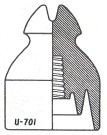
According to Tod's 3rd edition of the Porcelain In1ulator Guide Book, GE's
connection to electrical porcelain manufacture dates from 1887 when the Bergman
Electric Company hired a local potter named John Krauss. Krauss began
experimenting with dry process porcelain and then they began manufacture of dry
process pieces for Bergman's use. Bergman Electric was absorbed by Edison
Machine Company in the late 1880's, which became GE. According to Men and Volts,
The Story of General Electric (Hammond 1941), GE moved the Bergman porcelain
operation from 17th Street and Avenue B in New York City to Schenectady in 1889.
William Cermak, a porcelain specialist from Czechoslovakia, ran the porcelain
factory at GE in Schenectady at this time. Cermak is described as having
difficulty producing usable porcelain insulators by the dry-process.
"Experiment after experiment were made, scores of insulators were designed
and tested, only to go to pieces under less than 10,000 volts" (Hammond
1941). Cermak and his engineers are further described producing "the
well-known petticoated insulator which stood the test up to and beyond 10,000
volts". Cermak apparently knew that the dry process units left a lot to be desired. They continued further study and
design in an attempt to make good porcelain insulators for GE's installations.
An understudy of Cermak at this time, Edward M. Hewlett, later became well known
for development of the Hewlett suspension disc insulator in the early 1900's.
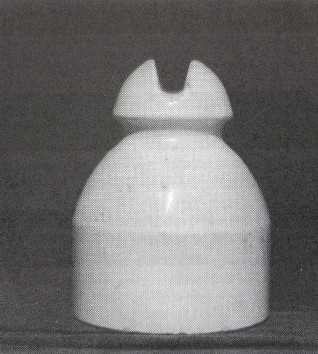
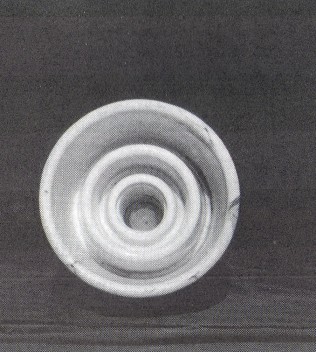
Full view and bottom view of U-701.
Nearly identical descriptions of GE's porcelain factory in Schenectady, New York
are given in articles in The Electrical Engineer dated May 1, 1895 and in
The
Electrical World, dated May 4, 1895. These articles describe the layout of the
small pottery and the manufacture of small dry press items such as sockets,
switch bases, cut-out switches and transformer connector boards. Brief mention
is also made of a small adjoining room where testing of high voltage porcelain
insulators occurred. Although several photographs of the operation are depicted,
this adjoining room is not shown. The articles state that "Among these
(insulators) may be mentioned the large double petticoat insulators for the
important power transmission plant at Folsom-Sacramento". These insulators
were supposedly subjected to a severe test of 25,000 volts alternating, and none
of the insulators gave way until 52,000 volts was applied. It is hard to believe
that any porcelain insulator could stand 52,000 volts in 1895, and this was
probably an exaggeration. The Folsom-Sacramento line mentioned in the factory
description is one of two known sources of the U-701.
The oldest installation
where porcelain pin-type insulators attributed to GE have been located to date
is the Baltic-Taftville, Connecticut line. According to an article in The
Electrical Engineer, dated May 2, 1894, this 2,500 volt DC line was constructed
by the Power and Mining Department of GE for use in supplying power to the
Ponemah Mill, located in Taftville. Conflicting with The Electrical Engineer
description, Men and Volts, The Story of General Electric (Hammond 1941)
describes the installation of an alternating current system in 1893. According
to Hammond (1941), an existing direct current generator installed at Baltic and
direct current motors at Ponemah (Taftville) were apparently proving
unsatisfactory in 1892. As a result they were replaced in late 1893 with new
polyphase alternating current generators and motors produced by the
Thomson-Houston plant of GE. From Hammond's more detailed information, it appears
that this was an alternating current line, possibly one of the earliest
installations of an alternating current transmission line in this country.
The Taftville line was also intended to provide power to the Norwich Street
Railway, although it is unclear if this ever occurred. Although a GE
installation at the Columbia Mills in South Carolina preceded Taftville, this
project was described as the first important use of electrical power
transmission to a textile manufacturer. The Taftville transmission line ran
from a hydro-electric generating station installed in an old rebuilt mill on the
Shetugket River in Baltic, 4.5 miles to Taftville. The transmission line, which
is depicted in a very small photograph (see below), consisted of wooden poles
100 feet apart that were run along the highway and the Shetugket River. The
poles contained two crossarms, each carrying a separate three phase circuit. The
upper line used No. 0 bare copper wire and the second lower crossarm carried No.
0000 insulated wire on four separate lines. The fourth line was installed for
use in case one of the other lines was damaged. The article states that "All
(wires) are supported on the General Electric Company's standard oil
insulators".
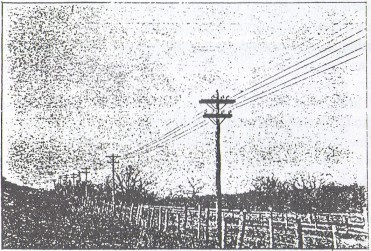
Taftville, Connecticut pole line, 1895.
The article also states that "the first motor started two months
ago", inferring that the line started in use in the beginning of March,
1894. Obviously the line was constructed prior to March 1894, with the
insulators also manufactured prior to this date, most likely around the end of
1893 or beginning of 1894.
The reference to GE' s "standard oil
insulators" adds some mystery to this installation as there are no known GE
oil-type insulators. The photograph of the line is low quality and the insulators appear to be
white porcelain, with a poorly defined shape. It is possible that these
insulators could be glass, as white porcelain often looks the same as glass in
many old photos. The U-701 is a white, unmarked dry process insulator with what
is commonly referred to as double petticoats and a shape unlike any other
domestic porcelain insulator. The shape of the insulators on the line are
difficult to discern and can not definitely be identified as the U-701. In the
1970's, a Connecticut collector acquired 4 or 5 of the U-701 insulators that
were previously removed by a lineman from the substation at the Ponemah Mill.
These insulators are assumed to be from the original 1894 installation of this
line.
If the U-701's found in the substation were also used on this line, it is
feasible that they were used with a small oil cup or tray installed underneath
the insulator, possibly explaining the description of an oil type insulator.
However, other than a description of an oil type insulator by Thomas, there is
no evidence that any other domestic companies manufactured a porcelain oil-type
insulator. Additionally, I have not heard of any 701s with oil staining as
would be expected of a relatively porous, dry process insulator sitting in oil.
The insulators depicted on the line could be glass and, although unlikely, may
have been different from those used at the substation. Since the U-701's were
found at this substation originally installed by GE, it makes sense that these
were part of the original installation in 1894. Although the Great Barrington
transmission line in 1893 used porcelain insulators imported from England, it
appears that the installation of the U-701's at Taftville may be the first use
of domestic porcelain pin type insulators used on a domestic power line.
Imperial reportedly manufactured their first double petticoat pin type porcelain
insulators in 1893 (The Electrical Engineer, Aug. 23, 1893), but there are no
known specimens that can be attributed to Imperial's manufacture prior to their
work for Fred Locke in 1895. It is possible that Imperial produced small dry
process pin types for telegraph installations and low voltage use prior to 1895.
Thomas was also making dry process insulators, but probably all small telegraph
styles.
The second and only other known installation of the GE U-701 appears to
be the Sacramento Electric Light & Power Company line between Folsom and
Sacramento, California. This line originated at a hydro-electric power station
located on the American River near Folsom. According to information on file at the Folsom Historical Society and
in an article in The Electrical World (dated April 6, 1895), Westinghouse was
first contacted to bid on the installation. GE got wind of the project and sent
representatives to investigate and bid on the project. GE successfully beat out
Westinghouse for the entire electrical and mechanical installation contract,
signing the contract in September of 1894 and commencing construction in October
of 1894. As appears typical of many early power projects, the company installing
the electrical components provided everything including generators, poles, wire
and insulators.
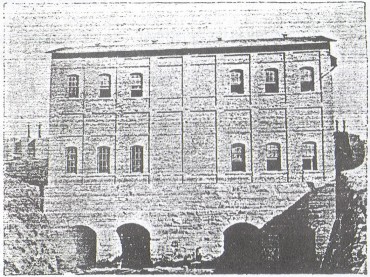
The power house of the Sacramento Electric Power
and Light Company at Folsom.
Interestingly, The Electrical World article also refers to the "excellent
work done at Taftville" in the beginning of the article. The article
further details the construction of the large dam and hydroelectric plant
using prison labor on the American River at Folsom. Construction of the dam was
completed in 1895 by the Folsom Water Power Company. The dam was used to store
water for irrigation, log storage and for hydro-electric power. The transmission
line, described as 11,000 volts alternating current, was run in duplicate for
20.5 miles from the Folsom power house to Sacramento along the line of the
Sacramento & Placerville Railway and country roads. A total of 2,600, 40 foot,
round cedar poles carried two crossarms, one for each circuit. Each circuit consisted of three bare copper wires supported on
''porcelain
insulators especially designed and made for this installation at the porcelain
factory of the General Electric Company, Schenectady". As described in the
articles detailing GE's factory, each insulator for the Folsom line was
reportedly tested to not less than 25,000 volts alternating, before leaving the
factory.
The Folsom-Sacramento line is also described in the September 1895
issue of The Journal of Electricity. This article similarly describes the
project and includes a photograph depicting the transmission line with four
white porcelain insulators on the top crossarm and two on the bottom crossarm.
As with the Taftville photograph, this photograph is too small to discern the
style of insulator. This photograph also depicts a third crossarm on one of the
pole lines. This lower crossarm carried the telephone lines of the Capitol
Telephone and Telegraph Company.
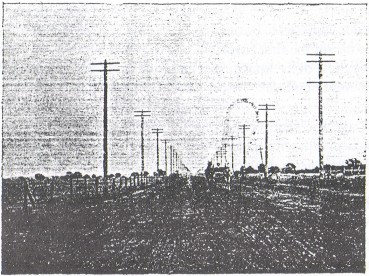
Double pole line transmission circuits on the Folsom pole line
- Sacramento
Electric Power and Light Company, 1895 -
Several of the U-701's have surfaced in the Folsom and Sacramento areas. Some
of the insulators have been found at flea markets in Sacramento. The most
intriguing find was the discovery of several U-701s near a dumping area in the
Sacramento River. The location of this dump is unknown at this time. The
description of the Folsom-Sacramento insulators (U-701) being specifically
designed for this installation leaves further unanswered questions about the
earlier Taftville line. The Taftville line (alternating current) was installed and in service
by March 1894. The construction work by GE on the Folsom line did not begin
until at least 6 months later (October 1894), and the line and insulators may
have been put in later in 1895 when the project went into service. This raises
several possibilities about the U-701 and its probable dates of installation.
If the U-701 was truly designed for the Folsom line then the most likely
explanation is that U-701' s removed from the Taftville substation were
replacements for an unknown original insulator (the oil-types previously
described?), and were probably installed in late 1894-early 1895. This could
explain the description of the oil-types in the original installation at
Taftville instead of an insulator like the U-701. Another possibility is that
the U-701 was an experimental design initially tested in small quantities in
the substation at Taftville.
Unfortunately, the conflicting descriptions of
these projects and the gaps in the available information lead us to speculation.
The U-701 does appears to be the first power pin type produced by GE, and may be
one of the first porcelain power pieces produced in this country. Very few of
the known specimens of the U-701 would be considered in mint condition. Most
have the fine black cracks and some chipping characteristics of most old dry
process porcelain. Considering the age and short period of time in which the
U-7011 would have been acceptable with quickly increasing voltages, it is
amazing that any of these pieces have survived to this day. The U-701's unique
shape and finely crafted dry process body represent to me one of the most
interesting and collectible classic porcelain pieces. The apparent rarity of the
U-701 (15-20 thought to exist in collectors' hands) as well as its place in the
history of early power transmission definitely make it a classic.
I would like to thank to Steve Jones, Paul Greaves and the Insulator Research
Service for help in researching this article.
References:
The Electrical Engineer, Aug. 23, 1893
The Electrical Engineer, May 2, 1894
The Electrical World, April 6, 1895
The Electrical Engineer, May 1, 1895
The Electrical World,
May 4, 1895 |
The Journal of Electricity, Sept. 1895
Hammond, J.W. 1941. Men and
Volts, The Story of General Electric
Permission granted by Elton Gish for use of U-701 shadow profile.
|
